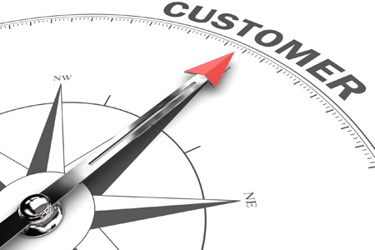Customer Centricity
By Zoe Fenwick

Customer centricity is a term that has been well used in business over the past decade. But what exactly does it mean? Why should you do it and what benefits can it bring?
Defining Customer Centricity
Many companies claim to be customer centric but that can often turn out to be lip service, with the aim of shifting as many units as possible combined whilst delivering a good level of customer service and satisfaction. Don’t get me wrong – high customer satisfaction and great customer service are really positive traits and a step in the right direction, but to be truly customer centric, you have to put the customer at the centre of your business.
Decisions need to answer the question “How does this help our customers?” Get into the mind of your customer and understand what makes them tick so the customer truly is at the heart of the business. Some consultancies such as Forrester even go so far as to state that organisations need to become “customer obsessed”.
It really is about changing the organisation’s mindset and culture and it goes beyond the traditional realms of marketing, sales, and customer service to cover every department across the entire breadth and depth of an organisation, from operations to finance and human resources.
Most importantly it needs to be a fundamental part of strategic leadership - your leadership team and senior executives need to understand that to be truly customer centric requires continuous investment in people, technology, and processes to ensure effective implementation and that this will be a cyclical process with ongoing discovery, evaluations, and outcomes.
How can it benefit your organisation?
Adopting a customer centric culture and mindset can help shape, not just your sales and marketing strategy, but the strategy for your entire business – after all without customers, you have no business. So why not do the best you can for them?
It can help you really understand what resources you need to best serve your customers - and bear in mind that can your customers differ depending on what stage of the customer lifecycle they’re at. It can help Improve brand trust by demonstrating that your company really does have the customer front of mind, and not just as a means to making money.
There is a plethora of studies showing how companies who adopt a customer centric strategy and culture perform better in terms of revenue and growth and create a more sustainable business in the long-term. Forrester outlines some of the benefits in this blog post about their Customer Lifecycle Framework:
- Improves the ROI of marketing spend.
- Accelerates new customer acquisition time cycles.
- Increases customer lifetime value.
- Creates a lifelong stewardship of the customer relationship.
- Drives customer value, loyalty, and advocacy.
Getting to Know Your Customers
So, you really need to get to know your customers – what problems are they trying to solve? What keeps them awake at night? What would really help transform their business and how can you add value?
As highlighted earlier, customer centricity requires a blend of data, technology, and people skills to help efficiency and effectiveness. Invest in and leverage these resources to help in listening to and creating a dialogue with your customers. Gaining qualitative feedback and combining it with quantitative data will really help further your insight into your customer’s mindset.
Remember - Not All Customers are Created Equal
Some thought leaders such as Peter Fader, author of the Customer Centricity Playbook (which I highly recommend!) believe that customer personas are an outdated method for developing customer centricity. They may not be perfect but if your company is starting from square one, they are better than nothing.
Most importantly, begin by calculating the customer lifetime value – this will help you identify your ‘best’ customers as not all customers are created equal. Using financial and purchasing data to assess frequency, value and length of relationship, combined with other forms of data can help you calculate and assess which customers offer you the most value.
Just be sure on your definition of value – it doesn’t have to be monetary or profit-based measures but satisfaction, loyalty, and advocacy. Examples could be time saved, increased productivity, better patient outcomes or even how often a customer uses a product or service – in the case of health insurance, the customer who maintains a healthy lifestyle and rarely makes a claim might be considered more valuable than more frequent claimants.
This doesn’t mean you should ditch the lower value customers as they still have their place. A healthy and balanced sales funnel includes customer acquisition, retention, and development opportunities across the customer life cycle. But it may mean reassessing how you serve those customers and adjusting certain processes and procedures so you can do so more efficiently and effectively, whilst still maintaining a high level of customer service and satisfaction.
Once you have identified your best customers, you can look at the influential roles within those customer decision making units – as with any complex B2B purchase, this often involves a team of people. You will probably start to notice common traits amongst those high value customers and roles, and from this you can start to build out customer personas or pen portraits.
Ideally, you should develop a persona for every role in the decision-making unit along the customer journey, but you can prioritise this according to the level of influence each role has upon decision making. Each role or persona will have their own challenges and preferences and it can help your team understand their mindset and answer some key questions around at what is important and what matters to them as well as helping to identify some of the sources of information and channels that they use, and also help identify which marketing strategy and tactics - acquisition, retention or development - might best apply depending on the customer lifecycle stage, so you can maintain a balance within your sales and marketing funnel and subsequent pipelines.
Just remember, although there are common traits, not everyone will fall neatly into a segment and there may be outliers. Consequently, you may need to adjust or revisit your personas over time as you gather more customer data and test the performance of marketing programs and campaigns designed around your customer insights. Whilst not perfect, customer personas can be an apt reminder and reference point to help ensure the customer remains front of mind when your teams are developing strategic marketing plans and programs.
Being Human and Being Authentic
The aim of customer centricity is to build a long-term relationship with your customer, showing how you can help solve their problems and add value to their business. It also pays to show how your company values align with those of your customers – a word of caution here as it must be authentic, and you need to actually abide by those values. Your customers will soon spot any phoney claims or behaviour.
Remember the whole person – your customer is more than just a consumer and businesspeople are still people underneath. People still buy people, even in a B2B context and it is that personal element which will be key to developing and strengthening your customer relationships.
Some companies have gone even further and built a strong human element into their corporate identity by actively using their employees in imagery and messaging. This can offer multiple benefits – helping to foster a sense of pride in employees and feeling valued, plus the more practical side of logistics and cost in producing photography and imagery - but most importantly a strong visual cue that gives your customer a chance to see who they might be actually working with, providing an authentic voice and tone to communications, rather than relying on stock imagery that can easily be replicated in competitor content and collateral.
And when it comes to thought leadership, attaching a face and name to a particular area of expertise can really lend credibility and demonstrates your organisation has the in-house expertise and experience that is necessary to help that customer. Combining these elements with the ongoing customer dialogue and active listening will help deepen your connection with customers, moving them up the ladder of loyalty and creating stickier relationships.
Employees are your biggest asset, really helping drive customer centricity and being a real source of competitive advantage that is unique and not easily replicated by competitors. This also brings benefits when recruiting and retaining top talent – employees and potential candidates can see the value a company places on its employees. And it is important to recruit employees who share the same values and ideals as your organisation and your customers, as it helps continuously drive improvements and maintain a customer centric culture – remember this a cyclical process which involves ongoing discovery, as your organisation, and strategy evolves over time to continue meeting customer needs.
About the Author
 Zoe Fenwick has accumulated over 20 years of experience in B2B Marketing, working for a number of leading brands including Oxford Biomedica, IQVIA and Mitel. She is passionate about leveraging best practices, frameworks, and technology to ensure a customer centric approach to strategic marketing. Zoe has consistently implemented a data driven approach to marketing, utilising customer journey insights and personas to create targeted marketing campaigns that deliver the right message, to the right person, at the right time, through the right channel, optimising campaign success and delivering quantifiable return on investment.
Zoe Fenwick has accumulated over 20 years of experience in B2B Marketing, working for a number of leading brands including Oxford Biomedica, IQVIA and Mitel. She is passionate about leveraging best practices, frameworks, and technology to ensure a customer centric approach to strategic marketing. Zoe has consistently implemented a data driven approach to marketing, utilising customer journey insights and personas to create targeted marketing campaigns that deliver the right message, to the right person, at the right time, through the right channel, optimising campaign success and delivering quantifiable return on investment.
